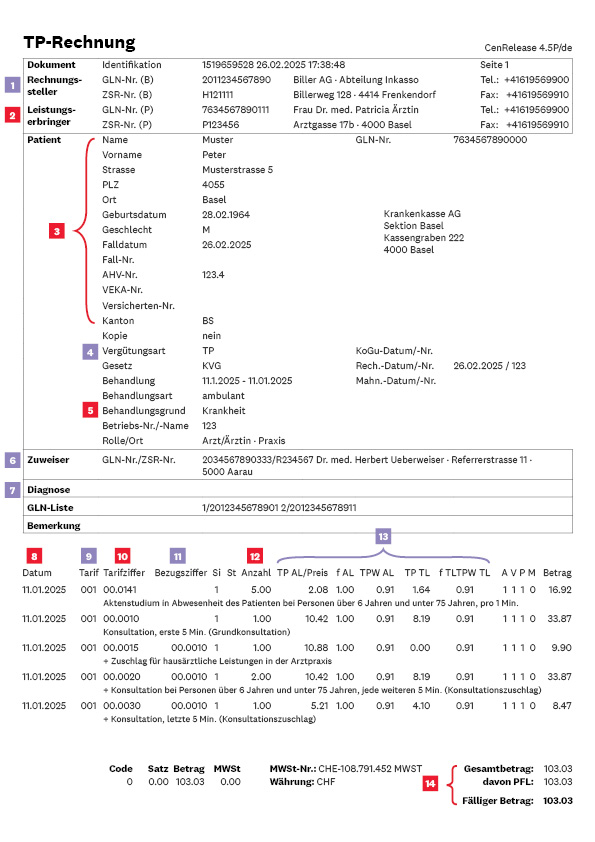Checking medical bills made easy
What does everything mean in the doctor’s bill?
Numbers, codes, abbreviations: Doctors’ bills are pretty technical and not self-explanatory. They are primarily used for payment processing between service providers (such as doctors’ surgeries, hospitals, therapists) and health insurance companies. We still recommend that you check them. You can find out here how a doctor’s bill is put together.
Good to know: As soon as Sympany receives a bill for you from a service provider, you’ll find it in the mySympany customer portal. You can report any discrepancies directly to us via a message in mySympany – or of course also by other means. Contact with customer service ›
Only you know whether you were undergoing treatment during the period indicated on the bill, whether the examinations stated were actually carried out and whether, for example, the number of billed medications is correct. Sympany cannot assess this. It might occur that an invoice is mistakenly incorrect – however, there are (rare) cases of malpractice (such as incorrectly charged COVID-19 tests during the pandemic).
Of course: Invoice verification is a key task of the health insurance companies and across the industry leads to savings of more than 3 billion Swiss francs per year, which has a direct impact on the premium. For example, it is checked whether the correct tariff has been billed. Invoices that have been incorrectly billed or are conspicuously high will be rejected.
How doctors’ bills are put together
As a patient, you can easily check the information on the invoice, which is marked with a red number.

Can be controlled by the patient
| 2 | Service providers: Were you treated by this service provider (doctor, hospital or therapist) or did they provide a service (e.g. laboratory examination) as part of your treatment? |
| 3 | Patient: Are your personal details correct? |
| 5 |
Reason for treatment: Is the correct reason for treatment (illness, accident, prevention) specified? This is important to ensure that the right insurance pays and that your co-payment is calculated correctly. As a rule, basic insurance pays for illness, accident insurance pays for accidents, and supplementary outpatient insurance often comes into play in the case of prevention. For example, in the case of gynaecological check-ups: basic insurance pays for this less the co-payment every three years; in the intervening years, supplementary outpatient insurance plus or premium covers 90% of the costs – but only if prevention is also specified. |
| 8 | Date: Were you undergoing treatment during the specified period or were you advised by telephone? Please note: Services may also be invoiced in the absence of the patient (e.g. reviewing files, clarifications with other service providers, writing reports, etc.). If you are unsure, you can ask your service provider. |
| 10 | Tariff number: Was the service listed (treatment, medication, medical aids) provided to you? |
| 12 |
Quantity: Is the specified quantity correct, how often the service was provided? It is easy to check the number of medications. Decode the duration of the encounter as follows: 00.0010 stands for the first five minutes, 00.0020 for all other five minutes, and 00.0030 for the last five minutes. Important: Reading and updating the patient file will also be charged. If you spent 20 minutes in the consultation but are charged 40 minutes, this may be correct. If the specified time seems too long, you can ask the service provider. |
| 14 | Total amount/amount due: Is the invoice amount correct (= the sum of the individual services listed above)? |
This is what the other information on the invoice means:
Person or institution that performs invoicing for the practice
Tiers garant (TG): The policyholder pays the invoice and reclaims the money from the health insurer.
Tiers payant (TP) means that the invoice goes directly to the health insurer. You will find it in mySympany as soon as we receive it – but your service provider is also obliged to send you a copy.
Service provider (e.g. family doctor practice) who arranged the service (e.g. laboratory examination) or referred you for treatment
The diagnosis is indicated with a capital letter and a number and is very general. Find out what the codes stand for here: Diagnosis Code for outpatient treatment (PDF, in German) ›
001 stands for TARMED, 400 for list of specialities. TARMED lists around 4,600 medical services. The list of specialities contains all medications that are covered by basic insurance. There are also a number of other tariff lists.
Good to know: You can enter the tariff number in the Tarmed browser (in German). Under “Medizinische Interpretation” (Medical interpretation), you will find a breakdown of what lies behind this item.
Sympany checks whether the applied tariff is correct.
Supplementary or supplemental service which requires a basic service (e.g. first and second hand x-rays).
TP AL = Tariff points for medical services
TP TL = Tariff points for technical services (e.g. costs for infrastructure such as rent, electricity or cleaning as well as non-medical staff)
TPW = Tariff point value
The same number of tariff points are charged for each service throughout Switzerland. The tariff point value varies from canton to canton. Multiplying the tariff point by the tariff point value gives the price of the underlying medical service (AL).
Sympany checks whether the tariff points and tariff point values have been settled correctly.